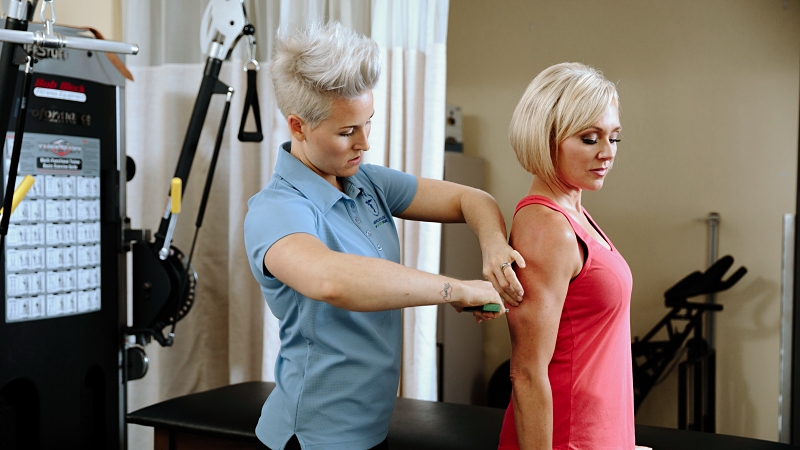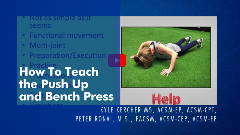Laurie A. Milliken, Ph.D., FACSM and Timothy Lohman, Ph.D., FACSM |
April
1, 2020

The editors of ACSM's Body Composition Assessment book recently presented a webinar entitled Getting on Track: Assessing Body Composition. Several important questions were asked during the webinar, and the answers are below.

Learn more about the book
Listen to the webinar
Q: Does dehydration lead to predictable direction of error? For example, if dehydrated, is percent body fat always higher or always lower?
For skinfolds it doesn't have a great effect, maybe very very small effect on skin itself and it would lower the percent fat dehydrated state, but it's more of a worry for BIA because there if you're dehydrated your water content is lower and you're getting more resistance than you need to because you have a lower water content. This does occur in one direction, and if you're over hydrated, it's in the opposite direction: you have more water and, therefore, you're estimating more lean and really have less resistance. So they do go in a predictable direction, but we really recommend not measuring BIA in the dehydrated or overhydrated state. The fasting state, following the procedure Lori gave [in the presentation] is the best.
Q: Which body composition method will give you the most value? Which is the best for the money?
If you're able to get a DEXA scan, I think that will probably give you a lot of information. It is on the expensive side, but you only need to get it done maybe two or three times a year and you don't want to get it done more often than that because there's an x-ray exposure to that. It gives you a lot of information; it gives you a bone density, total body and regional bone density, fat free mass in the total body and regional, and the same thing with fat. I think that's a really great method to get done if you want to get your body composition measured. But most practitioners who are out there practicing individually or in a gym, you can't go out and afford to buy a DEXA and so I would say that if you can get very well trained on one of those field methods. Either purchase a BIA unit that has decent accuracy so ask the company what their standard error of estimate is and make sure it's 3%-4% or smaller, and sometimes those devices you can get some reasonably priced ones at that error level or just get trained in skinfolds because that skinfold caliper is a couple hundred dollars and you get really well trained and you're off and running you get a pretty good estimate of body composition.
I'd love to see you all trained in all three methods so you can interpret the DEXA scans that come from the local DEXA machine, and that you can do BIA and skinfolds, and you can offer the client a choice. For some clients it may not be appropriate to do skinfolds, it may not work well for them at all, and BIA might be a lot easier for them. So if you're well trained in both, you can offer the person the choice. Skinfolds are good if you're good, and if the subject is open to skinfolds. BIA is a little easier for them to do.
Q: What are some teaching tips for teaching the undergraduate whose mindset is that there are machines to do these measurements?
When you start automating everything, you have drawbacks. You can’t think that a machine can do everything. It really is a valuable skill to be able to do a measurement with a skinfold caliper. In BIA, for example, you could show people how much it varies as hydration level varies. You could show how different it is when you choose a different equation, for example. If you could get a unit that gives you the raw data of resistance and reactance and then you could plug those numbers back into the equation. You can show that the equation that might be pre-programmed into the machine may or may not be accurate, and so there are some limitations to just going for the total machine/electronic kind of route because those have limitations and you really need to have a certain knowledge base under you.
Q: Is there a particular way an athlete or a client can purposely cheat the BIA or SKF methods in order to get a higher or lower result?
I think that’s possible, for BIA especially, because if someone can manipulate their hydration level and then they come in to get measured and they've told you they followed the pre-test precautions sure you can you can measure someone and if they are under hydrated or overhydrated that BIA value the percent body fat is going to change. As Tim said earlier that not so much for the skin folds if you're dehydrated skinfolds will be affected a little bit but BIA will be much more affected. You're really trusting the client when they come in and say they followed all of these pretest precautions really trusting them that they actually did and like I said you can't look at someone and know that they are normally hydrated but that's the assumption of BIA.
Q: What is the best way for fitness professionals to address the concept of prediction errors with clients that is a challenge?
I think that people are familiar with the idea if you give an example of 24% plus or minus 3, then you give the range 21% to 27%. I think they understand that. They have an estimate of percent fat and they know they lie probably somewhere between 21% and 27%. They could want a more accurate method than that, and then you can explain that this is a pretty good estimate with what we have today and if they want a little more accurate you can do the laboratory method, but you're going to still have a two percent plus or minus range and explain that to them just so they know that you have a choice of what methods to use but there are no perfect methods, we just don't have them. Down the road someone is going to invent one, and we're going to have a great method, maybe down to 1% but we're not there yet.
I think the other thing to emphasize is that you can't really look inside the body and see what's in there with many of these methods. So we have to rely on these techniques that have assumptions that have drawbacks and so to explain how the method works what it's based on and why it gives the number it gives and then some of the things that can affect that and make the errors go up or down.
Q: Does your book ACSM’s Body Composition Assessment discuss the new body composition method utilizing the optical body fat scanners?
Those are fairly new developments in the field and I don't believe we have addressed that in the book. Those are really new and still need to be validated against some criterion methods. I've seen some validations against some laboratory methods, but we need to wait a little bit to see what those validation studies against the four component model really show us.
We touch on it, maybe in a reference or two, but it's still too early. It's very user friendly. It's a promising technology but in terms of the accuracy it’s just not there yet. I just caution you about using it yet, but in the future we’ll be paying very close attention next year or two. Often, you hear great things about a new method and then when we really test it out, you find out it's not so on so we were being careful here too late for a little bit more research on this approach.
ABOUT THE EDITORS
Timothy G. Lohman, PhD, is a professor emeritus at the University of Arizona and is widely considered a leading scientist in the field of body composition assessment. His research includes serving as principal investigator (PI) of both the TAAG (Trial of Activity for Adolescent Girls) study—a collaborative multicenter study focused on physical activity of adolescent girls—and the Bone Estrogen Strength Training (BEST) study. He was co-PI of the Pathways Study, a collaborative study (by the National Heart, Lung, and Blood Institute; four field centers; and a coordinating center) designed to prevent obesity in Native American children. Lohman served as a consultant to the Women’s Health Initiative (WHI) Vanguard Center and Health ABC study of long-term aging, and he was an advisor on youth fitness for the Cooper Institute. He previously served as the director of the Center for Physical Activity and Nutrition at the University of Arizona. He is a member of the American College of Sports Medicine. He is the founder and President of the Global Health and Body Composition Institute which fosters body composition expertise, training and certification worldwide. Lohman recently co-edited ACSM's Body Composition Assessment.
Lohman’s additional works, published by Human Kinetics, include his co-edited Human Body Composition, Second Edition; his authored monograph, “Advances in Body Composition Assessment”; and his co-edited Anthropometric Standardization Reference Manual. His research in body composition helped to establish the chemical immaturity of children using the multicomponent model.
Laurie A. Milliken, PhD, FACSM, is an associate professor and former chair of the exercise and health sciences department at the University of Massachusetts at Boston. In the New England chapter of the American College of Sports Medicine (NEACSM), she has served as a state representative, an executive committee member, the Continuing Education Committee chair, and president, and she has been an active member since 1998. Nationally, she has served on the ACSM Research Awards Committee and is also an editorial board member of ACSM’s Health & Fitness Journal. She is currently a peer reviewer for leading scientific journals such as Medicine & Science in Sports & Exercise, the Journal of Applied Physiology, and the European Journal of Applied Physiology. She has been a member of ACSM since 1994 and has presented her research at many annual meetings. Her research interests include the regulation of body composition in response to exercise throughout the lifespan. She has received NIH funding for her work and is also a fellow of the American College of Sports Medicine. Milliken is also the CEO of the Global Health and Body Composition Institute and co-editor of ACSM's Body Composition Assessment.

View Popular Related Content

Top 5 ACSM Books of 2019

Top 5 Exercise Videos of 2019